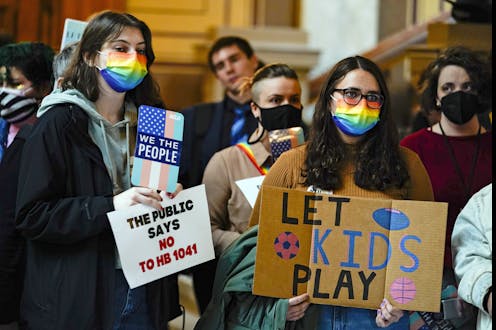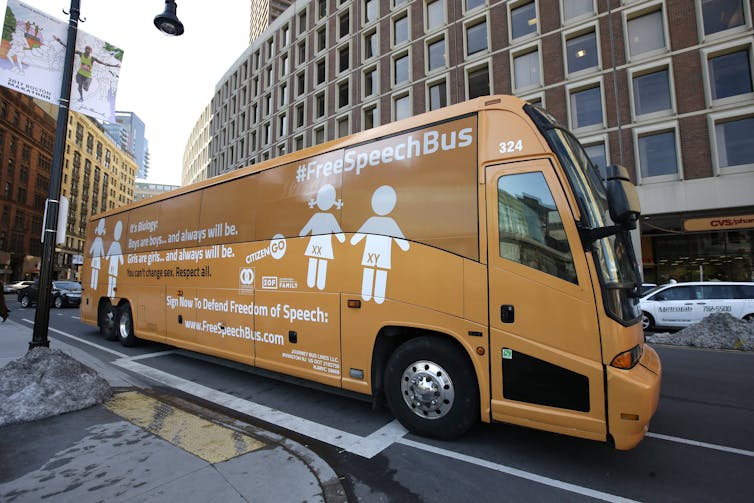Indiana, Iowa and Texas advance anti-transgender agendas – part of a longtime strategy by conservati
Bills baring transgender teens from girls’ sports and moves to investigate parents of trans children for potential crimes provide an uncertain and dangerous future for many.

Transgender girls in Iowa will no longer be allowed to compete in girls’ sports – the latest in a rash of anti-trans initiatives sweeping across the United States.
On March 3, 2022, Gov. Kim Reynolds signed into law legislation that affects transgender girls and women wanting to compete in accordance to their gender identity.
It comes just days after legislators in Indiana advanced a similar bill aimed at K-12 trans students.
That proposed legislation will now go to the Republican Gov. Eric Holcomb, who has previously indicated a willingness to sign the bill into law.
Meanwhile, in Texas, it emerged that officials had begun investigating the parents of transgender boys and girls for alleged child abuse. This follows an order by Texas Gov. Greg Abbott requiring “doctors, nurses and teachers” to report as child abuse any instance of a young person using puberty blockers or other gender-affirming medical treatments. The order allows for criminal penalties to be imposed on those who refuse to comply and on the parents of transgender children. A judge has halted the investigation into the parents of one trans teen, but set aside a broader ruling on the directive until a hearing on March 11.
Indiana, Iowa and Texas are far from being the only states advancing an anti-transgender agenda. More than 30 states initiated anti-trans legislation in 2021 alone, and at least seven more have done so this year to date.
These anti-transgender health care bills and legal interpretations are part of a package of initiatives that mark 2021 as a “record-breaking year” for anti-LGBTQ policies introduced in state legislatures across the country according to the advocacy group Human Rights Campaign. And 2022 is already on track to surpass this record.
These efforts include bills that will bar transgender athletes from participating in student sports, such as in Indiana and Iowa, and prohibit, or require parental notification of, any school curriculum that references sexual orientation or gender identity. One additional variety – signed into law in April 2021 by Republican Montana Gov. Greg Gianforte – requires gender reassignment surgery before any individual can change the sex marker on their birth certificate.
So far, anti-transgender athlete bills have gained the most traction. Despite consistent public opposition, more than 30 states have now considered barring transgender athletes from playing on teams that match their gender identity. Ten states have already enacted bans on transgender student athletes through legislation or executive order.
As a civil rights scholar, I have found that campaigns that mischaracterize LGBTQ-supportive policies as harmful to young people are a staple strategy conservatives use to galvanize their base.

‘Save our Children’
Anti-gay activist and Florida orange juice queen Anita Bryant first perfected the strategy in the 1970s to oppose ordinances prohibiting sexuality-based discrimination. Bryant’s “Save our Children” campaign demonized gays and lesbians as “recruiting children.” Bryant successfully encouraged voters to oppose legislative attempts to protect gays and lesbians from discrimination and prompted Florida legislators to bar same-sex couples from adopting children, a law that was overturned in 2010.
In the late 1990s and early 2000s, conservatives prompted over 40 states to bar same-sex marriage on the basis that all children could be at risk – those raised by same-sex couples and those introduced to marriage equality at school.
In 2015, when the Supreme Court overturned these bans in the landmark case Obergefell v. Hodges, conservatives began targeting transgender rights.
Conservatives again trained their focus on nondiscrimination measures – this time those prohibiting gender identity discrimination. They misleadingly argued that any measure protecting transgender individuals would place cisgender girls and women – individuals whose gender identity and birth-assigned sex are both female – at risk by allowing men dressed as women to use women’s locker rooms and restrooms.
There is no evidence supporting this claim. Yet there is significant evidence of health and safety risks to transgender students if they are prohibited from using bathrooms that reflect their gender identity.
Significant costs
Anti-transgender athlete and health care bills follow a similar approach. Advocates for bills targeting trans female athletes claim that transgender teammates will “ruin women’s sports forever.”
Supporters of anti-trans health care bills claim that children are being pressured to employ these therapies, by physicians and parents, and describe the effects as permanent and scarring.
There is little empirical evidence to back up these assertions. Puberty blockers are an increasingly common treatment precisely because they provide a reversible and less invasive option for transgender adolescents and are provided only with the patient’s fully informed consent. Cross-gender hormone treatments, which are typically provided in later adolescence, are also relatively low-risk.
And there is little evidence to suggest that transgender female athletes in K-12 settings are unfairly outcompeting their cisgender competitors – particularly if they have been on puberty blockers. In fact, conservative legislators have pointed to only one instance in their campaigns, when two trans female athletes in Connecticut took first and second place in a 2017 statewide track tournament. Several cisgender female athletes who lost, unsuccessfully attempted to sue state officials for permitting transgender athletes to compete.
A far more common story is the relative obscurity of transgender athletes in women’s sports and their similarities with their cisgender teammates. Many of the states considering the legislation have no known trans female athletes or have trans female athletes who are performing on par with cisgender female teammates.
And even the cisgender Connecticut athletes who attempted to sue state officials had prevailed in several championship races against their transgender competitors shortly after filing their lawsuit.
But none of this has prevented bill supporters from stoking fears.
Researchers and healthcare providers do know, however, that the bills will harm transgender young people.
Prohibiting gender-affirming care, like puberty blockers, or barring transgender-inclusive athletic teams imposes real and devastating risks on transgender youths. Transgender people who do not have access to the kinds of hormone therapies that are being outlawed are four times more likely than cisgender people to struggle with depression.
They are also nine times more likely than cisgender individuals to attempt suicide.
Put simply, gender-affirming policies and supportive health care therapies are lifesaving.
Furthermore, if upheld in court, the athlete bills could require any female athlete to “prove” their gender to participate, potentially through invasive physical examinations.

Political landscape
Conservatives may be using these bills – which some describe as “erasing transgender youth” – to catalyze Republican voters to participate in upcoming midterm elections. And the strategy could work.
Attempts to bar transgender athletes appeal to at least some self-described feminists. And some high-profile women’s athletes have joined the fray, convening the Women’s Sports Policy Working Group in order to “protect” cisgender female athletes from trans athlete inclusion.
Conservatives also used anti-trans-athlete talking points to oppose the Equality Act, a bill that would have added prohibitions against sexual orientation and gender identity discrimination to existing federal civil rights bills. The House passed a similar measure in 2021, but it failed to pass the Senate.
Transgender advocates have some recourse to fight the bills. Corporate backlash is one option. Litigation is another. Advocates for transgender rights have secured legal victories in state and federal court challenges involving bathrooms and locker rooms. More recently, a federal judge in Idaho blocked that state’s anti-transgender athletes bill passed in 2020.
And the Supreme Court’s 2020 ruling in Bostock v. Clayton County, which protects LGBTQ individuals from certain forms of discrimination, seems at first blush to support transgender student equality. But the Bostock case is relatively new, its application to sports and health care untested and political fervor is mounting. With a solid conservative majority on the Supreme Court – and in federal courts across the country – legal battles may be unreliable.
In the meantime, transgender young people across the country are contemplating a more uncertain and dangerous future for themselves and their parents. Some are working with their parents to find out-of-state sources for puberty blockers. Others are contemplating moves to less hostile states. All of this because conservatives have channeled trumped-up claims into harmful legislation that outlaws and endangers transgender youth, in an attempt to further divide American voters.
This is an updated version of an article originally published on May 6, 2021.
[The Conversation’s Politics + Society editors pick need-to-know stories. Sign up for Politics Weekly.]
Alison Gash does not work for, consult, own shares in or receive funding from any company or organization that would benefit from this article, and has disclosed no relevant affiliations beyond their academic appointment.
Read These Next
From truce in the trenches to cocktails at the consulate: How Christmas diplomacy seeks to exploit s
World leaders like to talk up peace at Christmastime. But alongside the tales of seasonal breaks in…
As DOJ begins to release Epstein files, his many victims deserve more attention than the powerful me
Powerful men connected to Jeffrey Epstein are named, dissected and speculated about. The survivors,…
How to reduce gift-giving stress with your kids – a child psychologist’s tips for making magic and a
Depending on family circumstances and a child’s personality type, gift giving runs the gamut of fun…






